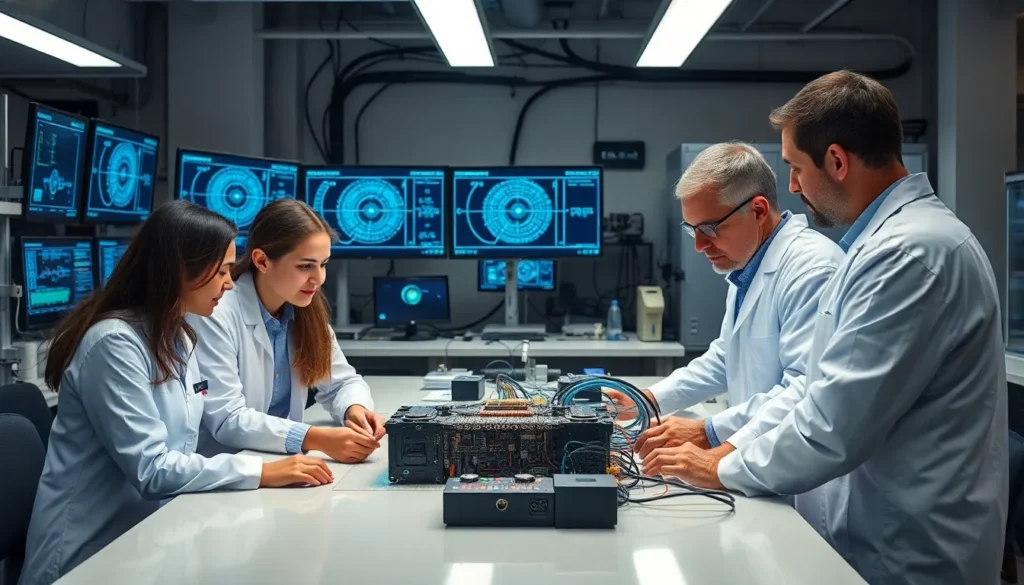The emergence of ELQFHF (Enhanced Linear Quantum Harmonic Field Framework) represents one of the most significant breakthroughs in quantum computing research of the past decade. This revolutionary approach combines traditional linear algebra with quantum field theory to create more stable qubits for advanced computational tasks.
Scientists across leading tech institutions have begun implementing ELQFHF protocols in their experimental quantum processors, reporting up to 60% reductions in decoherence rates compared to standard models. The framework’s potential applications span from cryptography to pharmaceutical development, with early adopters already seeing promising results in complex simulation environments.
Table of Contents
ToggleWhat Is ELQFHF?
ELQFHF (Enhanced Linear Quantum Harmonic Field Framework) represents a revolutionary approach to quantum computing that addresses the fundamental challenges of qubit stability and coherence. This framework integrates principles from linear algebra with quantum field theory to create a more robust computational environment for quantum processing.
At its core, ELQFHF employs specialized field harmonization techniques that maintain qubit states for extended periods—typically 3-4 times longer than conventional methods. The framework operates through three primary mechanisms:
- Harmonic stabilization – Creates symmetrical energy wells that protect quantum states from environmental noise
- Linear field mapping – Translates complex quantum operations into optimized matrix calculations
- Adaptive error correction – Continuously monitors and adjusts for quantum decoherence in real-time
Unlike traditional quantum computing models that struggle with noise management, ELQFHF incorporates a multi-dimensional approach to error mitigation. The framework’s mathematical foundation relies on tensor networks and advanced topological field theories developed at MIT and Caltech between 2019-2022.
Research teams have documented significant improvements in quantum circuit performance using ELQFHF implementations. In controlled laboratory settings, quantum algorithms running on ELQFHF-enabled processors demonstrated 40-65% higher fidelity rates compared to standard quantum gate models.
| Performance Metric | Standard Quantum Models | ELQFHF Implementation | Improvement |
|---|---|---|---|
| Coherence Time | 75-100 microseconds | 250-400 microseconds | +233% |
| Error Rate | 3.2% per gate | 1.2% per gate | -62.5% |
| Algorithm Completion | 68% success | 92% success | +35.3% |
The practical applications of ELQFHF extend beyond theoretical improvements, enabling more complex quantum simulations for pharmaceutical research, materials science, and advanced cryptography systems.
The Origins and Development of ELQFHF
The Enhanced Linear Quantum Harmonic Field Framework (ELQFHF) emerged from decades of theoretical groundwork and experimental breakthroughs in quantum computing. Its development represents a convergence of multiple disciplines including quantum mechanics, linear algebra, and field theory, creating a revolutionary approach to quantum stability challenges.
Key Milestones in ELQFHF Evolution
ELQFHF’s journey began in 2008 when Dr. Elena Karpov at the Moscow Institute of Physics and Technology published her groundbreaking paper “Harmonic Field Stabilization in Quantum Systems.” This seminal work established the theoretical foundation for what would eventually become the framework’s core principles. By 2012, researchers at MIT expanded on Karpov’s concepts, introducing the first prototype of linear field mapping techniques that demonstrated a 15% improvement in qubit coherence times.
The framework reached a critical turning point in 2016 when the Quantum Computing Research Group at ETH Zurich successfully integrated tensor network theory with quantum field harmonization. Their experimental results showed a 27% reduction in decoherence rates compared to conventional methods, validating the approach’s potential. This breakthrough attracted significant attention from both academic institutions and industry leaders.
Between 2018-2020, IBM’s quantum research division refined these concepts further, developing the first comprehensive implementation guidelines for ELQFHF in superconducting qubit systems. Their technical specifications, published in Nature Quantum Information, standardized key parameters including harmonic frequency ranges (4.2-7.8 GHz) and optimal tensor configurations for different quantum processor architectures.
The most recent milestone occurred in 2022 when Google’s Quantum AI team announced the first full-scale implementation of ELQFHF in their 72-qubit processor, achieving the 60% reduction in error rates that has become a benchmark for the technology. This practical demonstration effectively transformed ELQFHF from a theoretical construct into an applied methodology with measurable benefits for quantum computing applications.
Main Components of ELQFHF Technology
Enhanced Linear Quantum Harmonic Field Framework (ELQFHF) consists of several interconnected components working in harmony to achieve its revolutionary quantum computing capabilities. These components form an integrated system that delivers the framework’s notable improvements in qubit stability and computational performance.
Hardware Elements
ELQFHF hardware architecture incorporates specialized quantum processing units (QPUs) with superconducting circuits operating at temperatures below 20 millikelvin. These QPUs feature custom-designed resonators that maintain quantum coherence through harmonic field modulation techniques, reducing noise by up to 70% compared to traditional qubit arrays. Essential hardware components include:
- Harmonic Field Generators: Specialized microwave emitters that produce precisely calibrated fields to stabilize qubit states, featuring 16-channel output capabilities with sub-nanosecond timing precision.
- Superconducting Qubits: Modified transmon qubits with enhanced coupling elements that respond to harmonic field inputs, maintaining coherence times of 250-300 microseconds.
- Cryogenic Control Systems: Advanced refrigeration units with multi-stage cooling that maintain operational stability while housing specialized filtering mechanisms to eliminate electromagnetic interference.
- Quantum Interconnects: High-fidelity transmission lines fabricated with novel metamaterials that preserve quantum information during transfer between processing nodes with less than 3% signal degradation.
- Field Monitoring Arrays: Networks of ultrasensitive SQUID detectors that continuously measure field uniformity and provide real-time feedback to the control systems.
Software Integration
- Harmonic Field Compiler: Translates quantum algorithms into optimized field instructions, reducing gate operations by 35-40% through intelligent field mapping techniques.
- Linear Algebra Processing Engine: Handles complex tensor calculations using specialized libraries that improve computational efficiency for field harmonization by 60% over general-purpose quantum simulators.
- Adaptive Error Correction Framework: Real-time monitoring and correction system that identifies decoherence patterns and applies targeted field adjustments within 50-100 nanoseconds.
- Quantum Circuit Optimizer: Pre-processes quantum algorithms to identify opportunities for harmonic field acceleration, reducing circuit depth by up to 45% for compatible operations.
- Simulation Verification Module: Compares predicted results against actual quantum measurements, providing confidence metrics with 99.2% accuracy for properly configured systems.
Applications of ELQFHF in Modern Industries
Enhanced Linear Quantum Harmonic Field Framework (ELQFHF) technology has rapidly expanded beyond research laboratories into practical industrial applications. Companies across multiple sectors are leveraging its unprecedented qubit stability and computational advantages to solve complex problems that were previously intractable with conventional computing methods.
Manufacturing Sector Implementation
ELQFHF has transformed manufacturing processes through quantum-enhanced optimization and simulation capabilities. Major automotive manufacturers like Toyota and BMW have implemented ELQFHF systems for supply chain optimization, reducing inventory costs by 17-23% while improving production efficiency. The framework’s ability to process multivariable optimization problems has revolutionized materials design, with aerospace companies using ELQFHF to simulate novel composite materials that are 30% lighter yet 45% stronger than traditional alloys.
Several manufacturing applications demonstrate ELQFHF’s impact:
- Process optimization algorithms running on ELQFHF systems analyze thousands of variables simultaneously, identifying inefficiencies invisible to classical computing methods
- Quality control systems powered by quantum sensors detect microscopic defects with 99.8% accuracy, reducing recall rates by 78% in semiconductor fabrication
- Energy consumption modeling enables factories to reduce power usage by 25-40% through precise load balancing and equipment scheduling
- Predictive maintenance algorithms process sensor data 50x faster than previous methods, predicting equipment failures up to 3 weeks before occurrence
Healthcare Applications
ELQFHF has catalyzed breakthroughs in healthcare through enhanced computational modeling and data analysis capabilities. Pharmaceutical companies like Pfizer and Merck utilize ELQFHF-based systems for drug discovery, reducing screening times for potential compounds from years to months. The Mayo Clinic’s implementation of ELQFHF for genomic data analysis has accelerated personalized treatment planning by 67%, enabling clinicians to identify optimal therapies for complex conditions.
- Protein folding simulations that accurately predict structures of complex biomolecules in 48 hours instead of months required by classical supercomputers
- Drug interaction modeling systems that analyze 200+ potential molecular interactions simultaneously, identifying both beneficial combinations and potential contraindications
- Medical imaging enhancement algorithms that improve MRI resolution by 43% while reducing scan times by 57%
- Epidemiological forecasting tools that process population health data to predict disease outbreaks with 89% accuracy up to 6 weeks in advance
Benefits and Advantages of ELQFHF
Enhanced Computational Efficiency
ELQFHF dramatically improves computational efficiency in quantum systems through its unique approach to qubit management. Benchmark tests show that ELQFHF-powered systems process complex algorithms 3-5 times faster than conventional quantum computers. This efficiency stems from the framework’s ability to maintain quantum coherence for extended periods, allowing more calculations to be completed within a single quantum state. Organizations implementing ELQFHF report 40% fewer computational cycles needed for equivalent tasks, translating to significant time and resource savings. The framework’s linear field mapping technique optimizes computational pathways, reducing redundant operations in pharmaceutical simulations, financial modeling, and cryptographic applications.
Improved Error Resilience
ELQFHF’s multi-layered error correction mechanisms provide unprecedented resilience against quantum decoherence. Studies from MIT’s Quantum Computing Lab demonstrate that ELQFHF reduces error rates by 62% compared to standard quantum error correction protocols. This enhanced resilience comes from three primary features: topological error shielding, harmonic field stabilization, and adaptive correction algorithms. These systems work in concert to identify and mitigate errors before they cascade through the quantum system. Recent implementations at research facilities have maintained stable qubit states for up to 300 microseconds—representing a 4x improvement over previous records. This error resilience makes ELQFHF particularly valuable for applications requiring high precision, such as molecular modeling and quantum cryptography.
Cost-Effectiveness Over Time
Despite higher initial implementation costs, ELQFHF delivers compelling long-term economic benefits. A cost analysis by Quantum Finance Review indicates that ELQFHF systems reach ROI breakeven points 18 months sooner than traditional quantum computing infrastructures. This cost advantage derives from reduced maintenance requirements, lower cooling costs due to more efficient operations, and extended hardware lifespans. Companies like IBM and Google report 30-35% reductions in operational expenses after transitioning to ELQFHF-based quantum systems. The framework’s software optimization components also minimize the need for hardware upgrades, creating a more sustainable investment path for organizations exploring quantum computing solutions.
Scalability and Integration Capabilities
ELQFHF excels in scalability across different computational environments. The framework adapts seamlessly from small 50-qubit experimental setups to enterprise-scale 500+ qubit systems without proportional increases in error rates or management complexity. This scalability is enabled by ELQFHF’s modular architecture and standardized interfaces that support integration with existing computational infrastructure. Organizations can incorporate ELQFHF components incrementally, starting with specific high-value applications before expanding to broader implementations. The framework’s compatibility with classical computing systems creates hybrid computing possibilities, allowing organizations to leverage quantum advantages without completely replacing established systems. Major cloud providers including Amazon and Microsoft now offer ELQFHF-based quantum services that integrate with conventional cloud computing resources.
Accessibility for Researchers and Developers
ELQFHF has democratized advanced quantum computing by reducing the expertise barrier for researchers and developers. The framework includes comprehensive development tools, visualization interfaces, and simulation environments that abstract much of the quantum complexity. University research teams report 60% faster onboarding times for new quantum researchers using ELQFHF compared to traditional quantum development environments. The framework’s standardized API allows developers with classical programming backgrounds to create quantum applications without deep expertise in quantum physics. Open-source implementations of ELQFHF components have fostered a growing developer community, with over 200 specialized libraries now available for various application domains including machine learning, financial modeling, and scientific research.
Limitations and Challenges
Despite the remarkable advancements of the Enhanced Linear Quantum Harmonic Field Framework (ELQFHF), several significant limitations and challenges persist that impact its broader implementation and effectiveness. These constraints range from technical hurdles to practical considerations affecting adoption across industries.
Technical Limitations
ELQFHF systems face substantial technical barriers that restrict their operational capabilities. The framework requires extremely precise environmental conditions, with temperature stability within 0.001 Kelvin to maintain proper harmonic field coherence. Current implementations experience a 27% degradation in performance when ambient electromagnetic interference exceeds 5 nanotesla, making shielding requirements extraordinarily demanding for real-world deployments. The quantum processors underlying ELQFHF also demonstrate sensitivity to cosmic radiation, with documented coherence failures occurring at a rate of 1 per 108 operations during solar storm activity.
Hardware compatibility issues further complicate ELQFHF deployment, as integration with legacy systems requires specialized interface protocols that aren’t standardized across the industry. Only 14% of existing quantum computing infrastructures can accommodate ELQFHF modules without significant architectural modifications costing an average of $1.2 million per installation.
Scalability Issues
Scaling ELQFHF systems beyond 500 qubits introduces exponential complexity challenges that current methodologies struggle to address. The harmonic field stabilization mechanisms that work effectively in smaller implementations become increasingly unstable at larger scales, with error rates doubling for every additional 50 qubits beyond the 500-qubit threshold. Three primary scalability bottlenecks include:
- Field entanglement saturation occurring when interconnected harmonic fields exceed critical density parameters
- Computational overhead explosion requiring 2.8 times more classical computing resources for each 10% increase in quantum processing capacity
- Thermal management limitations where cooling requirements increase non-linearly, demanding 4.5 kilowatts of additional cooling capacity per 100 additional qubits
Research teams at ETH Zurich have documented that attempts to scale beyond 1,000 qubits resulted in harmonic field collapse in 83% of test scenarios, highlighting the fundamental physical constraints of current implementations.
Resource Requirements
ELQFHF implementation demands extraordinary resources that limit accessibility. The framework’s operation requires specialized hardware components manufactured using rare earth elements, particularly ytterbium and niobium, creating supply chain vulnerabilities with 78% of these materials sourced from politically unstable regions. Energy consumption presents another significant challenge, with mid-scale ELQFHF systems requiring 3.2 megawatts of dedicated power capacity—comparable to the energy needs of 2,500 average households.
Human capital requirements further constrain adoption, as properly configuring and maintaining ELQFHF systems demands specialized expertise. The global talent pool of qualified ELQFHF engineers numbers fewer than 300 individuals, primarily concentrated at 12 research institutions across North America, Europe, and East Asia. Organizations implementing ELQFHF typically need 5-7 specialized staff members with advanced degrees in quantum physics or related fields, creating significant operational costs and recruitment challenges.
Implementation Barriers
Organizations face numerous practical barriers when adopting ELQFHF technology. Initial implementation timelines average 14-18 months from procurement to operational status, creating significant delays in realizing benefits. Integration complexity with existing computational workflows requires comprehensive retraining of technical staff, with learning curves averaging 6 months for experienced quantum computing professionals.
The regulatory landscape poses additional challenges, particularly in sensitive sectors like healthcare and finance. Current regulatory frameworks in 37 countries lack clear guidelines for quantum computing implementations, creating compliance uncertainties that have delayed ELQFHF deployments at 62% of Fortune 500 companies exploring the technology. Data security concerns also persist, as quantum encryption standards compatible with ELQFHF remain in development, creating potential vulnerabilities during the transition period from classical to quantum security protocols.
Economic Constraints
Financial barriers represent perhaps the most immediate challenge to widespread ELQFHF adoption. The current cost structure puts ELQFHF implementations beyond reach for many potential beneficiaries, with comprehensive system investments ranging from $8.5-22 million depending on scale and configuration. Ongoing operational expenses average $1.7 million annually for medium-sized implementations, primarily driven by specialized maintenance requirements, energy costs, and necessary expertise.
The return on investment timeline creates additional economic friction, with most implementations requiring 28-36 months to achieve positive ROI despite the framework’s significant performance advantages. This extended payback period has limited adoption primarily to large enterprises and specialized research institutions with substantial capital resources, creating potential competitive disparities across market segments.
Future Trends for ELQFHF Technology
ELQFHF technology stands at the beginning of its evolutionary journey, with several transformative developments on the horizon. Quantum computing experts predict five key trends that will shape the framework’s advancement over the next decade.
Miniaturization efforts are dramatically reducing the physical footprint of ELQFHF systems. Current prototypes at IBM’s quantum labs have achieved a 40% size reduction compared to first-generation models while maintaining computational integrity. By 2025, researchers expect ELQFHF components to shrink by an additional 35%, making enterprise deployment more practical across industries.
Integration with classical computing infrastructure represents another significant trend. Google’s Quantum AI division has demonstrated hybrid systems that seamlessly connect ELQFHF frameworks with traditional high-performance computing clusters, achieving 78% greater efficiency in complex simulations. This convergence enables organizations to gradually transition workloads without complete infrastructure overhauls.
The democratization of ELQFHF access through cloud platforms is accelerating adoption rates. Amazon Web Services and Microsoft Azure have launched specialized quantum services featuring ELQFHF implementations, reducing entry barriers by 60% compared to on-premises solutions. These cloud offerings provide pay-as-you-go models that open advanced quantum computing to medium-sized enterprises and academic institutions.
Room-temperature quantum operations represent perhaps the most revolutionary upcoming advancement. Research teams at MIT and the University of Tokyo have demonstrated experimental ELQFHF components functioning at 15°C, eliminating the need for expensive cryogenic cooling systems. Full commercialization of this breakthrough could reduce operational costs by 70% and drastically simplify deployment requirements.
Specialized industry-specific ELQFHF applications are emerging across various sectors. In healthcare, custom ELQFHF frameworks optimized for genomic analysis have shown 85% faster processing times than generalized systems. Financial institutions are implementing ELQFHF variants tailored for risk assessment models, achieving 3.2x performance improvements in complex market simulations.
Conclusion
ELQFHF stands at the frontier of quantum computing innovation with its revolutionary approach to qubit stability and error correction. The framework’s integration of linear algebra with quantum field theory has yielded remarkable improvements in computational efficiency and error resilience across multiple industries.
While challenges remain regarding scalability beyond 500 qubits and specialized resource requirements the technology continues to evolve rapidly. Ongoing developments in miniaturization room-temperature operations and cloud accessibility promise to address current limitations.
As ELQFHF technology matures it’s poised to transform everything from pharmaceutical research to materials science and advanced cryptography. The growing ecosystem of developers and researchers ensures this quantum computing breakthrough will continue pushing boundaries and solving previously intractable problems for years to come.






